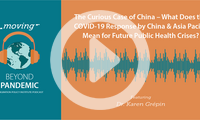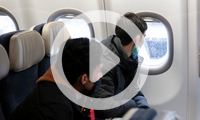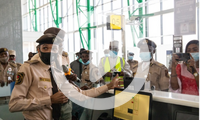COVID-19 Analysis and Data
Recent Activity

MPI's Lawrence Huang discusses COVID-19 mobility restrictions in China and the Asia Pacific—and what this all means for future public health crises—with Dr. Karen Grépin, a health policy professor at the University of Hong Kong.

Digital innovations—including automatic verification of health and vaccination results—are reopening economies and global mobility while setting the standard for new ways of managing mobility and health that will outlast the pandemic. Dr. Pramod Varma, chief architect of India's COVID pass system, DIVOC; Dr. Edem Adzogenu, founder of the Afro Champions Initiative; and MPI's Lawrence Huang discuss these innovations on this episode of Moving Beyond Pandemic.

On this webinar, speakers examine how government strategies, practices, and instruments of integration policymaking have adapted during the pandemic both in Europe and North America, and what lessons there are for the future.

This official side event of the International Migration Review Forum revists lessons from COVID-19, and explores the potential for greater international coordination over health and mobility and setting principles that are clear, equitable, streamlined, and future-focused.

Marking the launch of an IOM-MPI report, this webcast examines the state of mobility across world regions into the third year of the COVID-19 pandemic—what travel restrictions remain, what policy adaptations have occurred, and how do systems improve for the next public-health crisis.
Pages
Recent Activity
Some of the strictest COVID-19 pandemic-era limits on human mobility occurred in the Asia Pacific region. Border closures started in East and Southeast Asia in early 2020 and quickly spread through the entire region, in some cases remaining in place for more than two years. This report examines the approaches countries took and reflects on the immense costs and benefits of using border measures to tackle public-health risks.
The COVID-19 pandemic’s impacts on mobility in the Middle East and North Africa were immediate and wide-reaching. These include the world’s largest and most sustained repatriation efforts for stranded migrants, halted and reversed irregular journeys, and a reckoning with some countries’ reliance on foreign labor. This report examines how these impacts varied across countries in this highly diverse region, as well as the uneven recovery.
The COVID-19 pandemic hit South American nations at a time when many were already contending with major migration challenges. Historic levels of intraregional migration and displacement, notably from Venezuela, collided with countries’ attempts to stop the spread of a new threat to public health. This report examines the region’s responses to the public-health crisis, and the immediate and lasting impacts on cross-border movement.
The story of the COVID-19 pandemic in Europe is chiefly one of challenges to solidarity and coordination. Cross-border movement—even within Europe’s Schengen Area—ground to a halt, and countries took varied approaches to using travel measures in an attempt to slow the virus’s spread. This report explores the pandemic’s impacts on mobility to and within Europe, its challenges to European solidarity, and lessons for future public-health crises.
















Shifting Patterns and Policies Reshape Migration to U.S.-Mexico Border in Major Ways in 2023
A Post-Title 42 Vision for Migration Management Comes into Focus
How State Assessments Became and Remain a Driver for Equity for English Learners
Managing Mobility in the Pandemic Era Requires World to Buy In on Shared Principles
Opportunities Exist to Better Reach Dual Language Learner and Immigrant Families through Home Visiting Programs
Can Omicron Finally Get the World to Cooperate on Pandemic Mobility Management?
Labor Shortages during the Pandemic and Beyond: What Role Can Immigration Policy Play?
As the United States Lifts Travel Restrictions, Its New Vaccination Requirements Could Shape the Future of Global Mobility
It Is Too Simple to Call 2021 a Record Year for Migration at the U.S.-Mexico Border
Rebuilding the U.S. Education System for the Nation’s English Learners
Pages